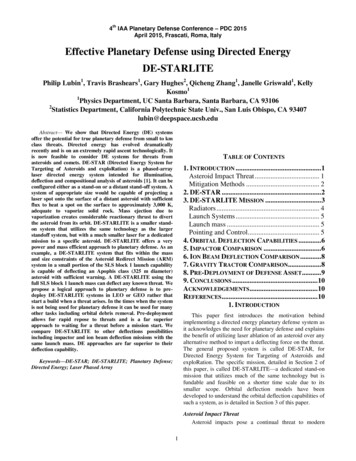
Transcription
PROTECTYOURSELFTHE SECRET OFUNARMED DEFENSEbyBROOKS MENDELLCopyright 1944NELSON DOUBLE DAY INC.NEW YORK
FOREWORDWhy is it that, in the battles of this war, men who have been reared in the ways of peace are provingthemselves, individually, masters of men who have behind them centuries of warlike tradition and yearsof specific training for war? An important part of the answer is their secret weapon—self-knowledge andself-confidence — which can be yours too. It is a knowledge which will enable you to perform feats youwould never have thought possible.In perfecting this system of self-defense in hand-to-hand combat, it has been the writer's goal to makeavailable to anyone a simple set of defense measures designed to be used in any emergency where one's person is in danger of physical assault. Fully explained both in pictures and words in the pages of this book, theseholds and throws enable you to protect yourself from the tricks of jujitsu, judo, mugging, and all forms ofphysical attack. It is a simple and direct science—a matter of knowing how your muscles and joints work,of understanding the vital relation between movement and balance, of knowing what your opponent's weakpoints are and what your own strong points are. And there is something more, when you have mastered thissystem—a confidence that comes to you with the knowledge that you have developed a set of mind-directedreflexes that will protect you, even in situations where ordinarily you would not have time to "think" w h a t todo next. The limitations of right- and left-handedness can be ignored, and even the advantage your opponentmay sometimes have in strength and size. The old adage—"In knowledge is strength"—was never more accurately applied than to the art of easy, effective self-defense in action.The men of our armed forces are all thoroughly grounded in ways of protecting themselves without theaid of weapons—it may mean the difference between life and death to them. But the principles upon whichthis system is based work equally well in games and bodily-contact sports of all kinds. Those who are notgood at group play or individual contests, who feel themselves physically inadequate and develop a feeling ofinferiority because of their lack of proficiency, can gain a new confidence when they learn to make use oftheir own potentialities. In any situation fear—and shyness or lack of confidence are only forms of fear—dullsthe mind, drains strength from the body, and interferes with the functioning of vital organs, thereby makinga person unfit to meet an emergency when it arises. It is fear, in its various forms, which is responsible forthe majority of failures and misfits in life. The knowledge that one possesses an unseen power that makeshim any man's superior, regardless of size or strength, is a vital tonic which reacts upon a man's whole beingby releasing him from fear. He finds himself, consequently, better able to adapt himself to his entire environment.Training of this kind can be used with great benefit to aid all physically incapacitated persons in regaining their self-reliance and self-respect, along with t h e use of their muscles. It is an excellent way to teach boysand girls "body-consciousness", bodily control and poise. In acquiring "body-consciousness"—the awareness ofthe f u l l physical potentials of a body which is directed by a mind free from f e a r — t h e child also gains amental balance and an understanding of the meaning of sportmanship t h a t come from perfect confidence inone's ability to meet and deal with any situation. Though this book is primarily designed to explain the physical aspects of this system, a short outline will be found on pages 91 to 96 of its uses in the field of education.All the members of the family can, and should, practice together. Women are learning as well as men, andMother and Son will be able to get as much out of this system as Father. It will all be in fun, of course, yetwith a few minutes' practice a day invaluable skill will be acquired.Brute strength alone will not suffice against this new science, any m o r e t h a n will the tricks of jujitsu andjudo. Any man, woman, or child, properly trained, is a match for a muscle-bound bruiser. It is now literallypossible for brains to best brawn.B. M.
CONTENTSFOREWORDATTACKS YOU MAY MEET AND OVERCOMEON GUARD. DEFENSE - BUT NOT DEFIANCE!YOUR ATTACKER'S WEAK SPOTSBODY DYNAMICS - GRAVITYBODY DYNAMICS - BALANCETHE HAND - A MANY-SIDED BLADEPRINCIPLE OF LEVERAGEDEFENSE AGAINST THE CLUTCHING HANDDEFENSE AGAINST ARMPIT NERVE PINCHHAVING FUN WITH DADDAD DOESN'T HAVE A CHANCEEFFECTIVE HAND GRIPS AND FINGER LEVERSHAND SHAKE - JUST IN FUNANTICIPATING TROUBLEKEEPING THE ATTACKER UNDER CONTROLMORE ABOUT HANDSHAKESTHE BREAKAWAYDEFENSE AGAINST JUJITSU AND JUDOHAND VERSUS FISTHAND DEFENSE VERSUS BLUDGEONELBOW DEFENSE AGAINST BODY BLOWSDEFENSE AGAINST A STRAIGHT LEFT OR RIGHT TO THE FACEALTERNATIVE DEFENSEANOTHER DEFENSE AGAINST THE ROUNDHOUSEDEFENSE AGAINST LEFT HOOKSURPRISE ACTION AGAINST UNSKILLED ATTACKERHAND-BLADE COUNTERSOTHER CONTROLS AGAINST STRAIGHT LEFT OR JABA FIRST PRINCIPLE OF DEFENSETURNING THE TABLES WHEN IN TROUBLEDEFENSES AGAINST EMBARRASSING AND DANGEROUS SITUATIONSDEFENSE AGAINST CHOKE OR FRONT ATTACKWEDGE BREAKS FRONT CHOKEBE TOUGH - WITHOUT GETTING ROUGH!BREAKING HEADLOCKALTERNATIVE METHODS FOR BREAKING HEADLOCKOUTWITTING THE JAP STRANGLERHAND AGAINST CHOKESEXPERT'S DEFENSE AGAINST CHOKE ON 9404142444546474849505152535455565758
BROOKSMENDELLThe system of defense in hand-to-hand encounter that you will learn from the following pages has beendeveloped through trial and error over a period of twenty-five years, beginning in the author's early youth.It grew from the realization that self-confidence, which should be acquired in childhood, is an all-important factor in later-life relationships, and that confidence in one's bodily control, as first evidenced in childhoodgames and group sports, is of great importance in the development of that self-reliance. This system may bepaced and adapted to many uses—by men, women, and children of any age. It is basically an education forliving, not for fighting.15
DEFENSE—AGAINST MUGGING1. The mugger uses a vicious backstrangle to overcome his victims.ATTACKS YOU MAY MEETAND OVERCOMEDEFENSEAGAINST JAP STRANGLE2. The dangerous Japanese strangleformerly considered fatal.
DEFENSE—AGAINST A KNIFE1. It takes more than nerve to meet coldsteel with bare hands.WITH TRAININGAND CONFIDENCEDEFENSE—AGAINST A CLUB2. A club is no more to be feared thana fist—if seen in time!
DEFENSE—AGAINST BOXER1. Outmaneuvering the fist-fighter.DEFENSE—AGAINST KICK2. Returning the vicious kick withinterest.DEFENSE—AGAINST KNEE3. The crippling groin PROTECTIONEASY18
DEFENSE—AGAINST JUGULAR STRANGLE1. A precarious situation—but not quite hopeless.DEFENSE—AGAINST ATTACK FROM REAR2. Looks impossible, yet it isn't. An attacker'sstrength and size can be used against him.DEFENSE—AGAINST UNWELCOME ATTENTION3. The girl is more surprised than the man! Withleverage alone she throws an attacker twice hersize and weight.
ONGUARDShouldersHands(Many-sided blades)Elbows (Arm levers)Side-bending musclesWith left leg advanced, arms raised,and palms open, Brooks Mendell's appearance says better than words, "I'mnot looking for trouble—let's be reasonable." Yet he is in the strongest possible position for defense ready forwhatever move an aggressor may make.He is poised, calm, and master of thesituation, though he may be out-matchedin skill, weight, and size.This position is the perfect defenseattitude. Every part of the body is setnaturally to meet and outmaneuver anattacker, whether he tries to use fists,hands, arms, or feet. And even thoughhe is armed with a knife or club, theadvantage may still be yours. You willbe poised to sidestep or sway out ofrange of the most headlong and desperate attack—and, as your attacker ismomentarily thwarted, he will be unable to protect all of his vulnerablepoints; if you know what to do, he willsoon be at your mercy.In the following pages you will learn a variety ofdefense tactics, simple yet highly effective, designed tomeet and overcome any form of expected or surpriseattack. When you have mastered them, the secretweapon will be yours.Remember—your body is an Arsenal of Defense inAction. Thighs- Knees (Leg levers)Calves-HeelsToesDEFENSE—BUT NOT DEFIANCE!20
YOUR ATTACKER'S WEAK SPOTSOver temple (nerve)Bridge of nose (nerve).Upper lip (nerve)Tip of chin (button)Under jawbone ——Adam's apple Depression at base of neckUnder armpitBelow hairlineBehind ear (mastoid)- Back of neck (nerve)Under ear (nerve) 'Jugular vein and carotid arterySide of neck (nerve)SubclavicalCollarboneArm socketFingersSolar plexusLower ribs (floating fibs)—— KidneyHandElbow socket ("funnybone")There is a special weapon at your instant commanddesigned to reach and inflict punishment on all of thesevulnerable points. For the sake of comparison the traditional pose of the fighter is shown, but the vital spotsapply to any adversary.In comparing this picture with the one on page20,note particularly the position of the right hands in both.The fist of the fighter has to travel much farther toreach his opponent. The comparative weaknesses andadvantages of these stances will become more apparentas you proceed through these pages.A powerful attacker is no stronger than his weakestpoint, and, as shown above, he has many of them. Everynerve that can be reached, every joint of his body—evenhis own strength and momentum—can be used againsthim.His feeling of confidence in superior strength especially will work to your advantage, for he will probablyattempt to overcome you first by direct blows which youcan easily parry. This will give you the opportunity youneed to reach his vulnerable spots and get him undercontrol before he can reorganize his plan of attack. Youwill also have the element of surprise in your favor.STRENGTH, WEIGHT AND SIZE—BUT NO ADVANTAGE!21
G R A V I T YG R A V I T YBODY D Y N A M I C SA cone or pyramid may have stability, and a man standingstill has stability if he is well balanced. A man walking on histwo legs has momentum, but no stability. Walking is an act ofbalancing, and is accomplished only by resisting the force ofgravity. Once the body's balance is even slightly disturbed it becomes necessary to expend energy to resist the pull of gravity inorder to prevent falling. This is the basic principle of body dynamics.1. Standing upon one leg, a man is entirely lacking in stability,and can balance himself only precariously and with effort.2. A man standing with his two feet spread apart in the normalstanding position, directly on line WE, is more stable, but theleast pressure either in front or behind, and over his center ofgravity—on a line with his navel—will throw him completely offbalance and force him to move his feet to keep from falling.3. Standing with his feet directly on line NS does not increasehis stability——4.—but let him face left sothat his feet are parallelingline NS and he has considerably greater stability. It isthis position, the "on guard"stance which offers the greatest defensive protection oroffensive advantage.Where greater force thana slight pull or push is required to throw a person offbalance, the lever principle isbrought into play. Here, youonly need to start your adversary in motion. His ownweight and momentum dothe rest. Every boy has proved this to his entire satisfaction.
BALANCEStanding upright—balance—is an acquired art. Unless properly balanced, a person's stability is easily upsetby causing his center of gravity to change.1. When a man is standing relaxed, or taken unawareswhen in motion, the pressure of a single finger appliedabove the center of gravity will throw him off balance.The taller he is, the farther his center of gravity is fromthe ground, the less force is required.2. A two-finger forward pull requires the application ofa little more force.3. A slight pull at your opponent's elbow or wrist, overyour extended leg used as a fulcrum, will throw himto the side.Remember that an attacker is always off balance atsome time as he makes the assault. Keep these threeangles in mind. One of them may save your life.
1. Held firmly, the edge below the littlefinger may be used as a cleaver or hatcheton a down stroke, or by swinging it tothe outside. It becomes a saber when making a. down sweep from the outside.2. The tips of the fingers, held rigid andwith the palm or the hand down, becomea lance to the throat, neck. eyes, andother vital points. With palm up theymay be thrust into the soft muscles oflvthe stomach.3. The inside of the hand may become aclose-range defensive weapon to parry andblock.THE HANDThe fist, contrary to a traditional belief, is only one of themany weapons at: our disposalfor self-protection. Nor is it byany means the most effective.Besides the fist, or bludgeon,the hand may become a hatchet,lance, club, pike, saber, orcleaver.4. Thumb and fingers, when used properly, are levers, pincers, and wrenchesagainst vulnerable spots such as nervecenters.5. The heel of the band is backed by thef u l l weight and strength of t h e bodywhere power and leverage are demanded.6. Bent knuckles form a blunted lancewhich, if accompanied by a corkscrewtwist and supported by t h e arm and shoulder muscles, is much more effective thanthe — 7. fist in reaching certain vulnerablespots. With this time-honored weapon,there must he perfect coordination andtiming, bucked up by the f u l l momentumof the body. if a specific target is to bereached. The slightest s h i f t or movement of the opponent's body causes theblow to miss the target. Since the a t tacker's body must be set before the blowis started, once under way its course cannot be changed without losing most ofits effective power.,24
BODY LEVERS AND WEDGESThe principle of the lever is the basis of many of themethods shown in these pages. We are all familiar withthe use of a bar resting over some object, such as astone, to pry up another stone of great weight whichcould not otherwise be budged. Fingers, hands, and legscan all play their part as levers in overcoming thegreater weight and strength of an antagonist with theminimum of effort on your part—if they are used correctly.1. Here is a double-finger lever, with each thumb actingas the fulcrum.2. In this hand lever, the fingers act as a vise, with thewrist as the fulcrum.3. The arm lever is produced by a forearm fulcrumand downward pressure from the other hand, againstthe hinge action of the trapped arm. (Fingers, knees,and elbows all have the limited action of a hinge, andforce applied against this action can easily snap thebone.)4. This leg lever shows a thigh as the fulcrum with theother leg applying the pressure against the hinge actionof the ankle and knee.5. Combination lever and lock, applied by one armusing the other as a fulcrum, against the hinge actionof wrist and elbow.6. The wedge, formed by hands and forearms, is another fundamental mechanical principle- For an upwardsweep, it is used to break an attacker's grip on yourneck.This diagram showing the fulcrum and the action ofthe lever applies in principle to most of these pictures.25
DEFENSE AGAINST THECLUTCHING HAND1. Remember that you are not looking for trouble. Yourwhole bearing should be one of "Now, let's settle thispeacefully—1 don't want to make trouble."2. If your adversary grasps your arm, merely drop yourhand over his and reach under with your other hand.3. Join your two hands and pull upward and inward.This will force his knees to buckle, in order to relievethe pressure, and he will try to release his hold; but hewill be at your mercy. (See page 76, figures 1 and 2for wrist grasp.)26
DEFENSE AGAINSTARMPIT NERVE PINCH1. Pressure of thumb against exposed nerve on underarm below armpit is very painful.2. To break this hold, grasp the top of the offendingarm, lock your opponent's hand in the crook of yourelbow, and press down.3. Join your hands and press downward with both,bending forward as your hands pull against each otherand toward your body.27
SHOWING UP DAD1. Start with a regular handshake, then proceed to showDad that he is no match for his son.2. Step forward with your right foot beyond Dad'sright foot as you raise his arm, and slip under it. Keepa firm grip on his hand so that the hand and arm willturn.5. Now complete the turn by stepping back with yourleft foot so that you are behind him and facing his back.With your left hand, grasp his left arm near his shoulder, at the same time forcing his bent right arm againsthis back.4. Now all you need to do is hold his hand firmlyagainst his back and hold onto his other arm to makehim say, "Uncle!"5. Here is how it looks from the back.
DAD DOESN'T HAVE A CHANCEAll right Dad, it's your turn to work the trick. (Don'tlook now, but Dad is in for another surprise.)1. Dad is going to try it now, so he shakes your hand.2. He steps forward and under your arm, just as youdid with him.5. But before he can turn your arm to your back, youstep forward with your left foot and place the palm ofyour left hand cupped over his elbow.4. Pushing upward and away with your left hand, andpulling down with your right, you force his arm intoposition. You can now pull it up behind his back, andDad is trapped again.Practice these simple holds to demonstrate the easewith which an adversary's strength can be neutralizedand his bodily movements controlled. Take turns placing yourself on the "receiving end" and you will appreciate the slight pressure required to gain mastery overan opponent.29
EFFECTIVE HAND GRIPSAND FINGER LEVERS1. If someone's hand grasps your lapel or shirtfrontwith thumb pointing up, get under his thumb with yourown, grasp his hand with your fingers, and press awayfrom you to force his wrist down.2. If the offending thumb is pointed down, apply afinger vise by pressing your opponent's thumb inwardtoward the palm of his hand and squeezing, with fingers placed as shown.3. To break an intentionally painful handclasp, simplybend at the knees to feign great discomfort, slip yourhand forward, and grip his thumb with your thumb andforefinger. Using your middle finger to form a leveragainst his wrist, push his thumb backwards towardshis wrist.4. If an attacker presses one hand — say, his left —against your chest preparatory to striking you with theother, simply hold that hand firmly against your chestwith your right hand—5.—.bring up your left hand, bend forward, and pressdown on his wrist with both hands; he will lose allinterest in hitting you with his right.
JUST IN FUN——or for that rare occasion when a deceptive handshake is intended to take advantage of you.1. Bend slightly from the knees, going with the pressure.2. Raise your opponent's right arm, quickly step underit.5. Bring your left arm up as you straighten your bodybehind his arm.4. Drop your bent left arm over his arm, locking thelatter in your armpit, with the palm of your hand alonghis forearm or wrist. By pulling up with your righthand and dropping your left shoulder, you exert pressure on his taut elbow and have him in a vise. If hegrabs your wrist, take his wrist and follow the sametechnique.
ANTICIPATING TROUBLE1. Your entire bearing shows that youprefer to avoid trouble, but you remainon the alert. If the aggressor's hand—right or left—starts toward you, firmlygrasp two or more fingers with yourhand nearest him.2. Turn his palm upward and force hisfingers back toward his wrist. This willcause him to rise on his toes as youapply additional pressure by raisingyour elbow.3. Greater leverage can be obtained inthis hold by using your free hand topress up on Ins elbow at the nerve center. If this does not tame him, moredrastic means are at your command, asshown elsewhere.32
KEEPING THE ATTACKER UNDER CONTROL1. Hold the attacker's wrist with your right hand and clamp his arm in your left armpit.2. Grasp his fingers with your left hand and force them inward toward his wrist.3. Apply leverage by pulling his thumb and fingers in opposite directions.4. Another equally effective measure is the two-hand finger and thumb lever against his thumb and little finger, pressing down with your thumbs and pulling up with your forefingers.33
MORE ABOUT HANDSHAKES1. Starting from a handshake or when your hand orwrist is grasped, step forward quickly on your left footand pivot to the right. As you do so, pull your adversary's arm straight out and downward, keeping it closeto your body. Drop your left arm over his extended arm,holding the latter in your armpit.2. By pushing downward with your right arm andreaching under his arm with your left hand you havehim trapped in an elbow vise where you can now applythe necessary leverage.3. By merely joining your hands or grasping your otherwrist, you can convert this hold into a painful lock.34
THEBREAKAWAYWhen being forced to follow against your will, there are few holds from which you cannot escape.1. Here your captor may think he has you under his control—but watch!2. As you fall into step with him and catch the rhythm of his stride, suddenly feign great pain. As he stopsand shifts his weight to his left leg, crash your right knee into the calf of that leg. He will be forced torelease you as his knees bend to prevent a broken leg.LAPEL AND ARM-LEVER HOLDIf an aggressive move is made to grasp your hand orwrist, here is another simple defense. Hold onto theaggressor's hand or grasp his wrist and reach under hisextended arm. Take a firm grip high on his far lapelwith your free hand. Pull down with your right arm,and painful pressure is applied to his captive arm. Thistechnique may also be used to subdue an intoxicated orunruly person who is seated.35
DEFENSE AGAINST JUJITSU AND JUDOThe typical cross-armed, open-handed position usedby the Japanese is essentially defensive in nature, having been designed for defense first and offense second.Jujitsu, meaning "gentle art," is a sport. Judo, strictlyJapanese, is a more advanced art embodying all the different systems of legendary jujitsu, which is supposed tohave been originated by monks in ancient days. Judowas designed and has been developed to give a physically inferior people advantage in physical combat.1. Here you see the Japanese and Mendell "on guard"positions. The following pictures illustrate the relativemerits of each.2. With the Jap's left arm held on the inside, an attempted left hook or straight punch would be blockedby his left arm as shown. His right hand could comeforward to attack your face, in which case your righthand would block him.3. If the Jap's right arm is on the inside, he wouldblock a right-hand punch with his right and attack withhis left. Here your open left hand is an effective block.4. It should be noted that the judo approach is met inthe same "on guard" position as all the others demonstrated in this book.5. Study these last two pictures closely and you willsee how easy it is to block either attack completely andhave a hand free to reach the attacker's solar plexus.
HAND VERSUS FISTThis demonstrates a basic principle: a straight line is the shortest distance between two points.1. Since the boxer's fist has farther to travel than yourleft hand, the knuckles of your bent fingers reach hischin first. By giving an inward swing and twist of thewrist, the knuckles of your fingers fit into the notch onthe side of his chin, jarring a sensitive nerve. Becauseof the shape of the hand in this position, much lessforce is required than if a fist is used.2. Close-up showing the knuckles making contact—your opponent's momentum is working against him,adding greatly to the force of the blow.3. This effective defense in action, straight lance thrust,is defensive and offensive at the same time. Practice itin front of a mirror by stepping forward with your leftfoot as you thrust your left hand forward and drawyour right foot into position. Then repeat the forwardarm action as you step back and away or to either side.A tall person has an advantage if he uses his handsand legs to keep an adversary at arms length.37
BLADE VERSUS BLUDGEON1. Comparative positions: the boxer stands with his leftarm extended and fists clenched; Mendell with bodyperfectly balanced, left foot forward, hands open toprotect head, elbows down to protect body.2. A left jab or straight punch to the chin is parriedwith the palm of the right hand, and the blow is diverted from its intended course. Mendell's open hand provides maximum surface for protection and gives greatercontrol and power.3. A left hook to the chin is blocked by the back of theright hand, which again diverts the blow from thetarget.4. Parrying a straight right to the chin with the palm ofthe left hand. This is not meeting force with force, butmerely diverting the blow from its intended target,which takes less strength and energy.5. Blocking a right hook to the chin with the back ofthe left hand. The hand and arm which are not engagedare always on guard against the adversary's other fist.Hold your arms relaxed, but firm enough to meet hisnext move and ready to counter it.Note that these are purely defensive moves. Counterand attack measures follow.38
DEFENSE AGAINST BODY BLOWS1. The outside of your right elbow blocks a wide lefthook to the stomach.2. A straight inside left to the body is parried by theinside of your right elbow, turning the blow inward andrendering it harmless.3. The inside of the left elbow parries a straight rightto the stomach.4. To block the curved blow of a wide right hook tothe body, use the outside of your left elbow as you usedthe right in Number 1.With a little practice you will soon learn to cushionsuch blows and absorb their power. Practice with acompanion using his open hand until you have acquiredthe knack of recoiling with the blow enough to neutralize its force. The defensive tactics outlined abovecannot be used against an expert boxer, who can feintyou out of position unless you understand his methods.39
DEFENSE AGAINST A STRAIGHT LEFT OR RIGHT TO THE FACE1.This for a straight right or roundhouse to the face. Parry it at your opponent's elbow as you slip back byswaying at the hips and shifting your weight to your right foot. Hold your right hand ready to block a sudden left-hand blow.2. Grasp your opponent's right wrist with your right hand, pull sharply down to the left, as you force hiselbow to remain up by pushing against it with your left hand. This push-pull action will be enough to discourage further aggression. (See page 69 for methods of maintaining continued control when the occasiondemands.)5. Against a straight left, slip inside t h e blow by leaning slightly forward and to the left as you sway at thehips, thus shifting your weight forward to the left foot. As the blow passes over your shoulder, grasp youropponent's elbow in your right hand and hold his armin the crook of your neck and shoulder. Your left handis ready to block his right.4. A strong downward two-hand pressure on the captured arm at the elbow will take all the fight out ofyour attacker.Feint attacker out of position, mislead him as to yourintentions, don't let him anticipate your movements.Then use attacker's own efforts and momentum againsthim by appearing to "give way" to avoid trouble or"ride with" the blow as in boxing—and then counter tobring him under control.40
ALTERNATIVEDEFENSE1. Sway back and to the right from a left jab by shifting your weight to the right foot, and drop your headslightly to the right. Parry at your opponent's elbow instead of at the back of his palm. As the attackingfist passes your shoulder, with the force of its momentum spent, your right hand grasps the attacker's forearm.2. At the same time you raise your left hand and place it over your right, then pull down hard with bothhands, locking the attacker's arm in the crook of your elbow. This calls for split-second timing, but will incapacitate your opponent completely.
ANOTHER DEFENSE AGAINSTTHE ROUNDHOUSE1. The blow is blocked by your left hand-blade, whileyour right hand is held on guard against the attacker'sleft.2. Your left hand grasps his forearm as you step forward on your right foot, and your right arm movesswiftly around his neck.3. With your right hip now pressed against your opponent's hip, pull his right arm around and down, exertingadditional pressure with the arm now encircling hisneck.4. You bend forward suddenly at the waist, and hisfeet are lifted from the ground.42
ANOTHER DEFENSE AGAINSTTHE ROUNDHOUSE5. In one continuous motion, pull with your arms andpivot your shoulders. The attacker should describe acomplete arc over your hip, landing with his feet on theground.6. Now you let him fall on his back.7. Resting on your left knee with his right arm heldtaut across your other knee, which acts as a fulcrum, heis at your mercy. If the situation warrants it, your righthand-blade is ready to inflict further punishment.A short person has an advantage if he gets in closeand uses the various throws.Before you practise "defense in action" visualize theillustrated attacks. Then go through the movementswith a friendly person who will study them with youin slow motion.Note! It is not necessary to complete the throws orplace any great pressure on the locks or holds.43-
DEFENSE AGAINST LEFT HOOK1. Here your right hand grasps your adversary's leftbelow the elbow, while your left remains on guard.2. At the same time, step forward on your left foot,placing it around and behind his left foot, meanwhilegrasping his left shoulder with your left hand. He isthrown off balance and is unable to use his right fist intime.3. This is another and more effective, safer method.Here, take a short forward ste
It grew from the realization that self-confidence, which should be acquired in childhood, is an all-important factor in later-life relationships, and that confidence in one's bodily control, as first evidenced in childhood games and group sports, is of great importance in the development o










